Rock beds around your house can add a stylish touch while also providing practical benefits. They help with drainage, reduce weed growth, and create a low-maintenance landscaping solution. Whether you’re looking to spruce up your outdoor space or solve soil erosion issues, rock beds are a great option that brings both form and function to your yard.
Rock Bed Drainage Solutions
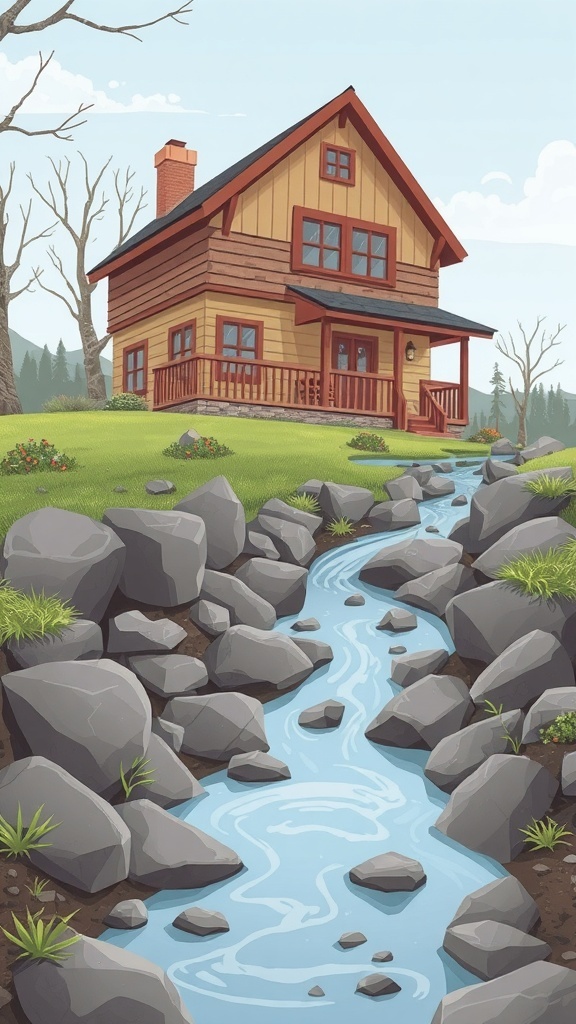
Rock beds around a house can serve as both a functional and aesthetic feature. They help manage water drainage effectively, preventing soil erosion and flooding. In the image, we see a charming house with a stream flowing through a bed of rocks. This setup not only looks appealing but also plays a vital role in directing water away from the foundation.
Using rocks in landscaping can be a smart choice for drainage solutions. The gaps between the stones allow water to flow freely, reducing the risk of pooling. It’s important to choose the right size and type of rocks to ensure they fit well with the overall design of your yard.
Incorporating plants around the rock beds can enhance the look while also helping with drainage. Native plants are often a great option as they are well-adapted to local conditions. They can stabilize the soil and absorb excess water, making your landscape both beautiful and functional.
Color Schemes for Rock Beds
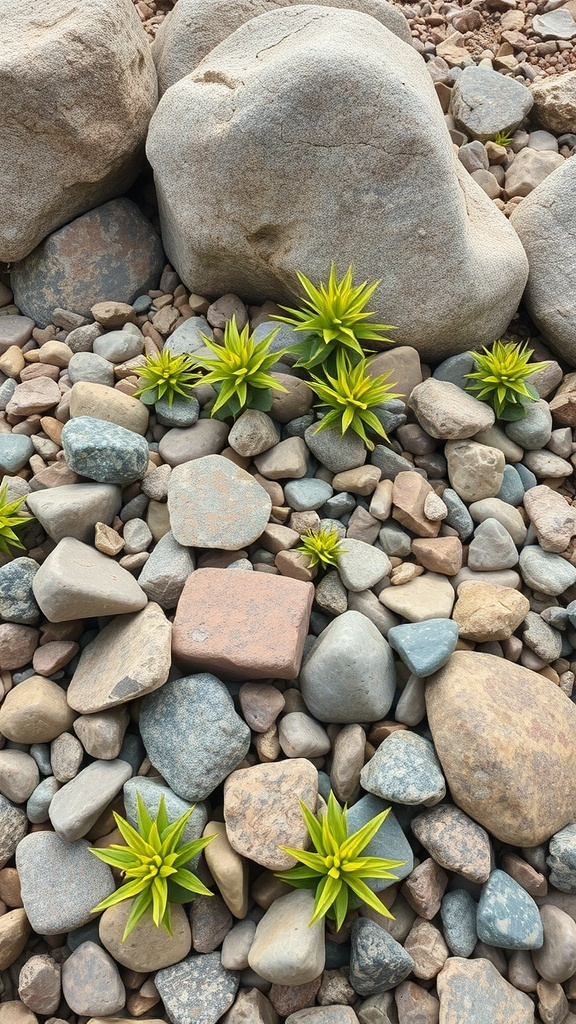
Rock beds can add a unique touch to your home’s landscape. The image shows a mix of smooth and rough stones, creating a natural look. The vibrant green plants popping up among the rocks bring life to the scene.
When choosing colors for your rock beds, think about how they will complement your home. Neutral stones like grays and browns work well with most house colors. You can also mix in some colorful stones to add interest.
In this image, the combination of earthy tones and bright greens creates a pleasing contrast. This color scheme not only looks good but also helps the plants stand out. Consider using similar colors to create a harmonious look in your own yard.
Don’t forget about the size of the stones. Larger rocks can serve as focal points, while smaller pebbles fill in gaps nicely. Mixing different sizes can add depth and texture to your rock bed.
Benefits of Rock Beds for Landscaping

Rock beds are a fantastic choice for landscaping around your home. They offer a unique blend of beauty and practicality. The image shows a vibrant rock bed filled with colorful flowers and lush greenery, creating a stunning visual appeal.
One major benefit of rock beds is their low maintenance. Unlike traditional gardens that require regular watering and weeding, rock beds need minimal upkeep. The rocks help retain moisture in the soil, reducing the need for frequent watering.
Another advantage is the variety they bring to your landscape. You can mix different types of rocks and plants to create a personalized look. The combination of textures and colors can enhance the overall aesthetic of your yard.
Rock beds also help with drainage. They allow water to flow freely, preventing pooling and erosion. This is especially beneficial in areas with heavy rainfall.
Lastly, rock beds can attract beneficial wildlife. Birds and insects are drawn to the flowers and plants, adding life to your garden. This creates a balanced ecosystem right in your backyard.
Maintenance Tips for Rock Beds
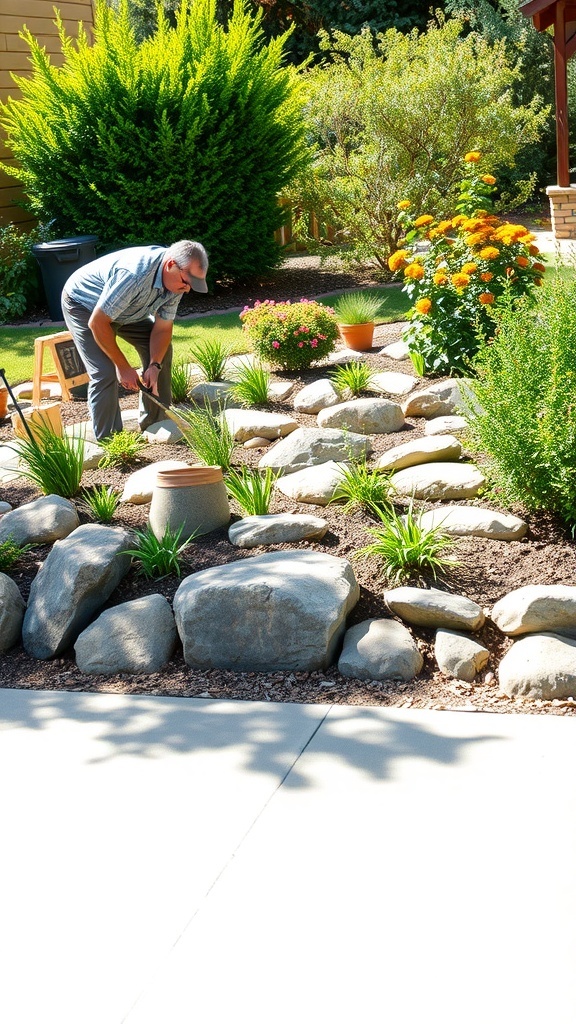
Rock beds can add a lovely touch to your home’s landscape. They’re low-maintenance and can help with drainage. However, they still need some care to keep them looking their best.
Regularly check for weeds. Even though rocks can suppress weed growth, some pesky plants may still pop up. Pull them out by hand or use a hoe to keep your rock bed tidy.
It’s also a good idea to refresh the rocks occasionally. Over time, dirt and debris can accumulate. Rinsing the rocks with a hose can help restore their natural look.
In the image, a person is tending to their rock bed, showing that a little attention goes a long way. Keeping the surrounding plants healthy also enhances the overall appearance of the rock bed.
Lastly, consider adding mulch or decorative stones to fill in any gaps. This can help improve the look and prevent erosion. With these simple tips, your rock beds will continue to be a beautiful feature around your house.
Rock Beds for Erosion Control
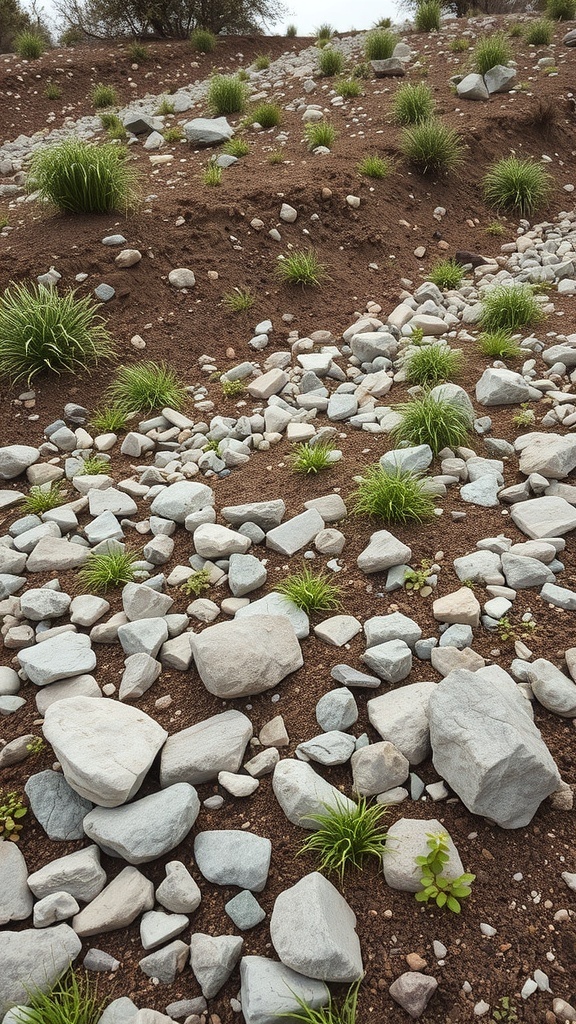
Rock beds are a fantastic way to manage erosion around your home. The image shows a landscape filled with various sizes of rocks and patches of grass. This setup not only looks appealing but also serves a practical purpose.
The rocks help slow down water runoff, allowing it to soak into the soil instead of washing it away. This is especially useful on sloped areas where erosion can be a big problem. The grass adds a nice touch, helping to hold the soil in place while also adding some greenery to the space.
Using rock beds can be a simple yet effective solution for homeowners looking to protect their property. They require minimal maintenance and can be a stylish addition to your yard. Plus, they can help create a more stable environment for plants to thrive.
Creating a Rock Bed Border
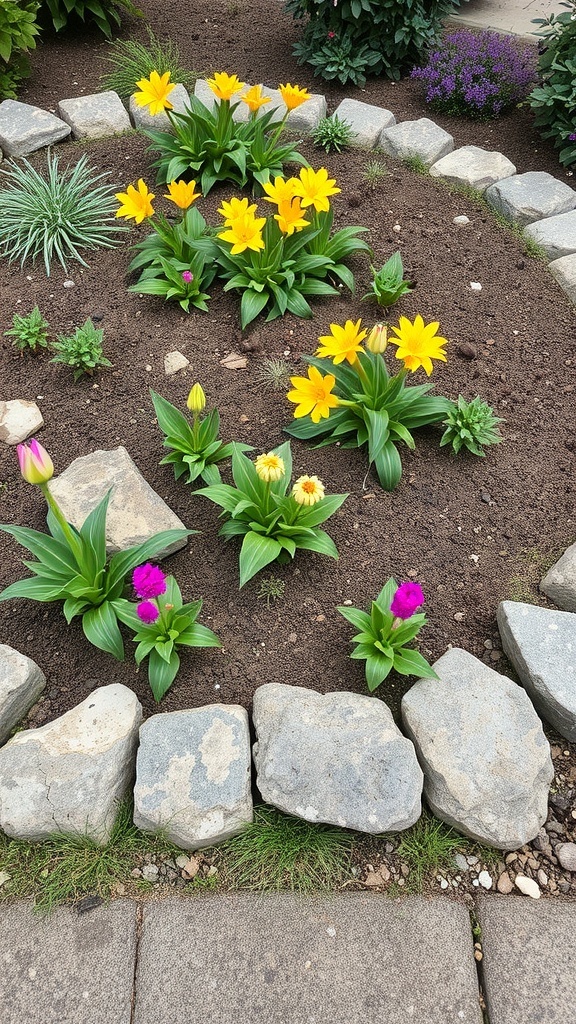
Rock beds are a fantastic way to enhance your garden’s look. They create a natural border that defines spaces and adds texture. In the image, you can see a lovely arrangement of colorful flowers surrounded by smooth stones. This setup not only looks appealing but also helps keep the soil in place.
Using rocks as a border is practical too. They prevent weeds from creeping into your flower beds and can help with drainage. The stones in the image are placed neatly, giving a clean and organized appearance. You can choose rocks that match your garden’s style, whether that’s rustic or modern.
When creating your rock bed border, start by outlining the area you want to define. Lay the stones down to see how they fit together. Adjust as needed until you’re happy with the layout. Once set, you can fill the space with soil and plant your favorite flowers, just like the vibrant yellow and pink blooms shown here.
Choosing the Right Types of Rocks
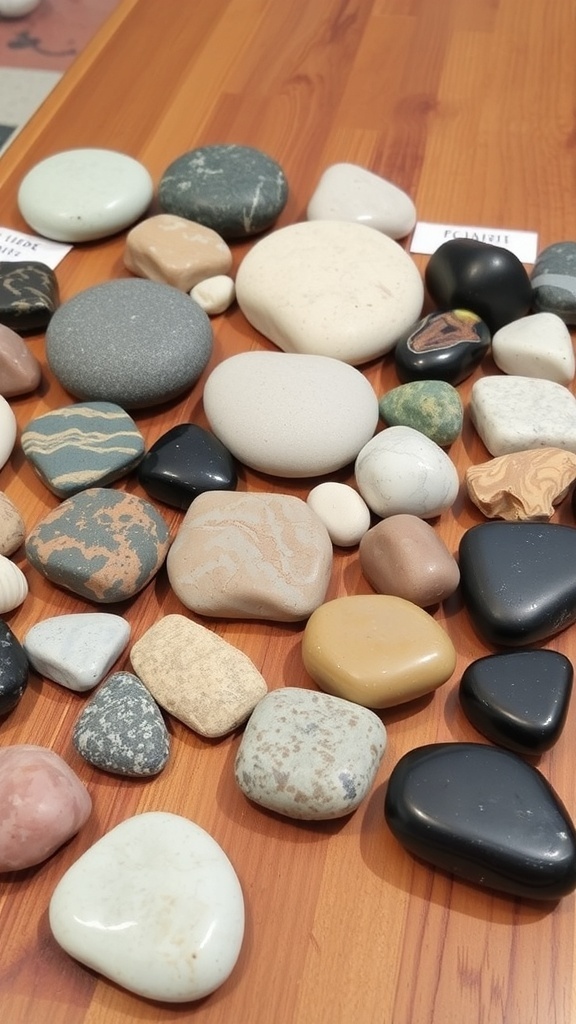
When it comes to rock beds around your house, picking the right type of rocks can make a big difference. The image shows a variety of stones, each with unique colors and textures. These rocks can add character to your landscape.
First, think about the look you want. Smooth river rocks can give a clean, polished appearance. On the other hand, rough stones can create a more natural, rustic feel. You might want to mix different types for a more dynamic look.
Next, consider the size of the rocks. Smaller pebbles are great for pathways, while larger stones can be used as focal points in your garden. The right size can help with drainage and prevent weeds from growing.
Don’t forget about color! The stones in the image range from light to dark shades. Choosing colors that complement your home can enhance its overall appeal. Think about how the rocks will look against your plants and other landscaping features.
Lastly, think about maintenance. Some rocks may require more upkeep than others. Smooth stones might need occasional cleaning, while rough stones can be more forgiving. Choose what fits your lifestyle best.
Incorporating Succulents in Rock Beds
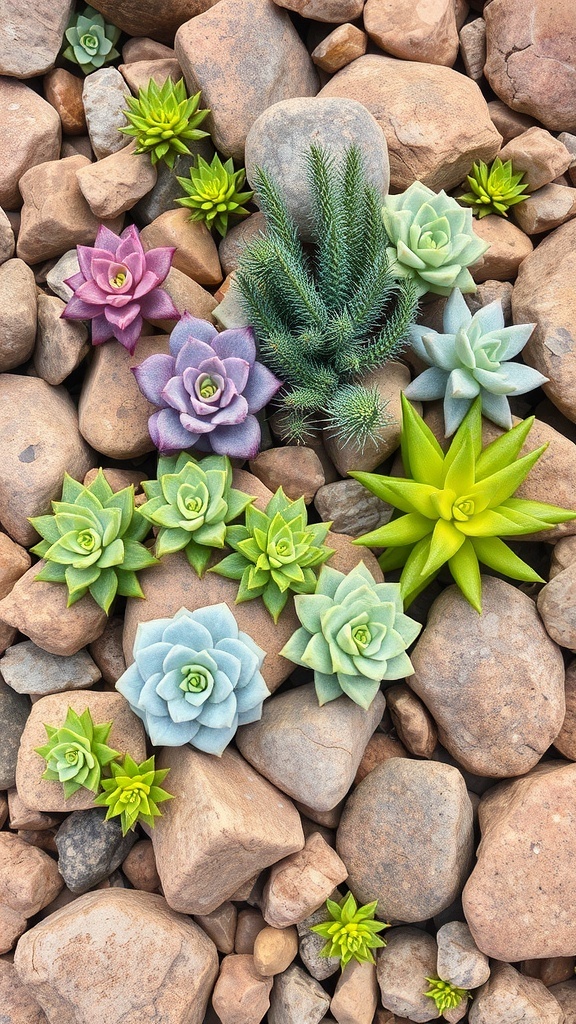
Rock beds are a fantastic way to add texture and interest to your outdoor space. They create a natural look that pairs beautifully with various plants. One of the best choices for these beds is succulents. These hardy plants thrive in dry conditions and come in many shapes and colors.
In the image, you can see a lovely arrangement of succulents nestled among smooth stones. The vibrant greens and purples of the succulents pop against the earthy tones of the rocks. This contrast not only looks appealing but also highlights the unique features of each plant.
When choosing succulents for your rock bed, consider mixing different varieties. Some have rosette shapes, while others are more spiky or trailing. This variety can create visual interest and make your rock bed stand out. Plus, succulents are low maintenance, making them perfect for busy homeowners.
To get started, select a sunny spot in your yard. Prepare the soil by adding some gravel or sand to improve drainage. Then, arrange your succulents in a way that feels natural. You can even add some decorative stones or driftwood for extra flair. With a little creativity, your rock bed can become a stunning focal point in your garden.
Rock Beds as Habitat for Wildlife
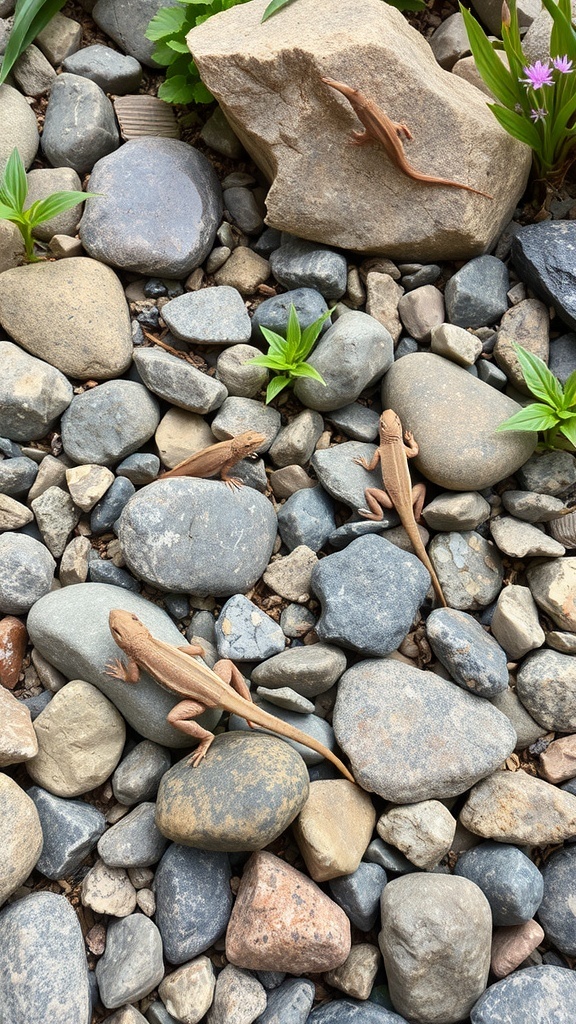
Rock beds around a house can be more than just a decorative feature. They create a unique habitat for various wildlife, making your garden a lively space. In the image, you can see several lizards basking on the rocks. These little creatures thrive in such environments, finding warmth and shelter among the stones.
The rocks provide a perfect hiding spot for lizards and other small animals. They can dart in and out, avoiding predators while enjoying the sun. This natural setup encourages a healthy ecosystem right in your backyard.
Plants growing between the rocks add to the charm and provide food for insects and birds. This diversity attracts even more wildlife, turning your rock bed into a vibrant habitat. By creating these spaces, you not only enhance your garden’s beauty but also support local wildlife.
Seasonal Changes in Rock Beds
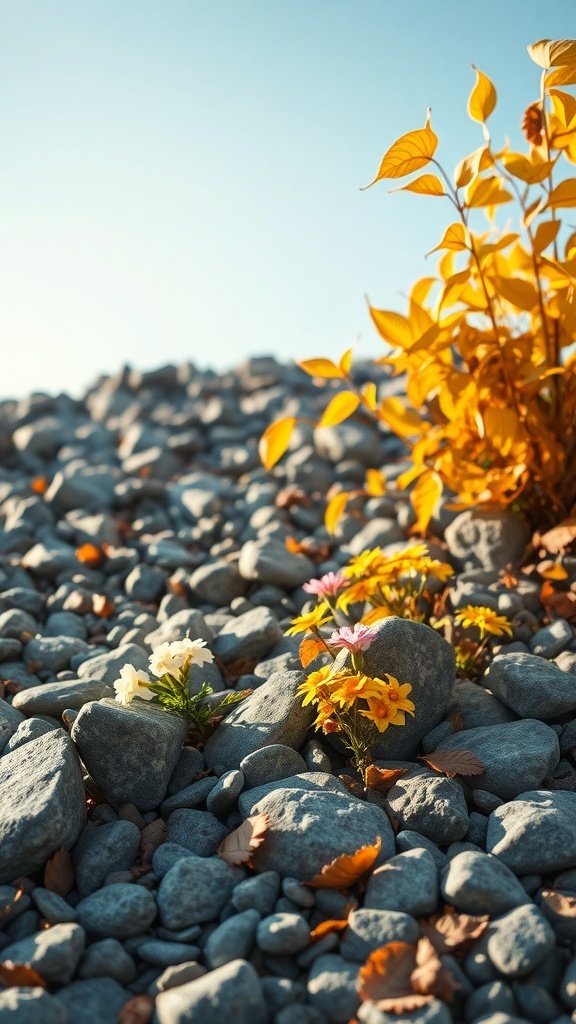
Rock beds around your house can change dramatically with the seasons. In the image, you can see a mix of smooth stones and colorful flowers peeking through, showcasing the beauty of autumn. The vibrant yellow leaves contrast nicely with the gray rocks, creating a warm and inviting scene.
As the seasons shift, the rock beds can take on different personalities. In spring, you might see new blooms emerging, while summer can bring lush greenery. When fall arrives, the leaves change color, adding warmth to the landscape. Winter can strip the area bare, leaving a serene, quiet beauty.
Maintaining rock beds throughout these changes can be simple. Regularly check for weeds and remove any debris. Adding seasonal flowers can also keep the area lively and colorful. This way, your rock beds will always look their best, no matter the time of year.
Combining Rock Beds with Pathways
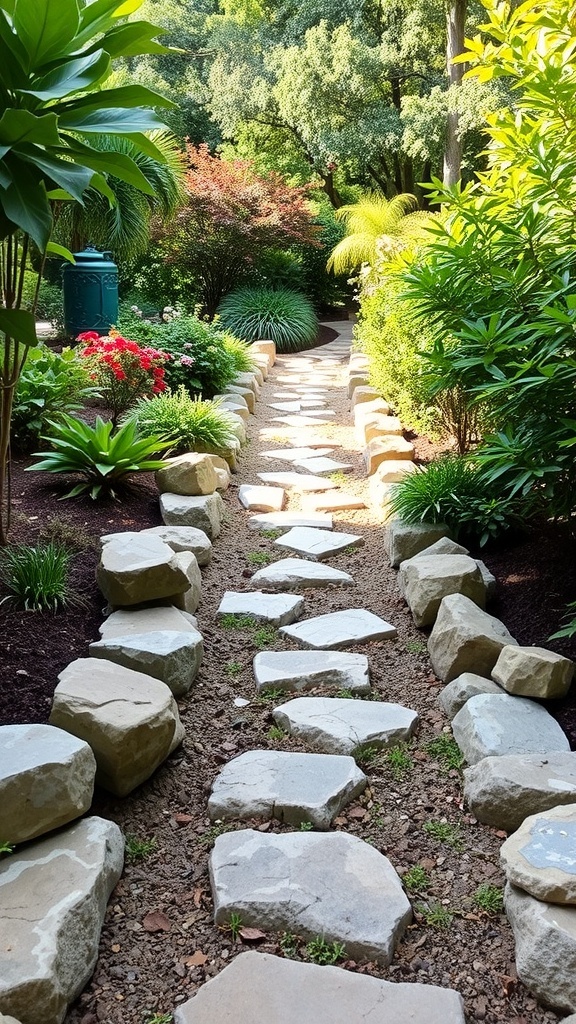
Rock beds and pathways can create a beautiful and functional outdoor space. The image shows a winding path made of stone slabs, bordered by rocks and lush greenery. This setup not only looks great but also helps in managing water drainage.
The stones in the pathway guide you through the garden, making it easy to explore. They add a natural feel, blending seamlessly with the surrounding plants. The use of rocks on either side of the path enhances the design, creating a defined space that feels inviting.
Incorporating rock beds around the house can also reduce maintenance. They require less watering and weeding compared to traditional flower beds. Plus, they provide a sturdy base for the pathway, ensuring it remains stable and attractive over time.
Overall, combining rock beds with pathways offers both beauty and practicality. It’s a simple way to enhance your outdoor area while making it easier to navigate.
Rock Bed Design Ideas for Small Spaces
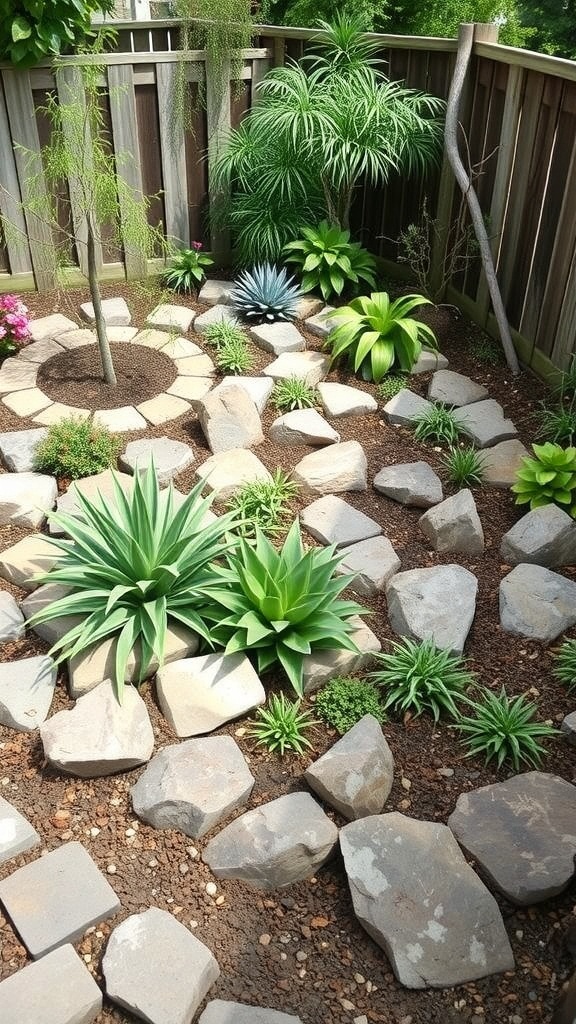
Creating a rock bed around your house can be a fantastic way to enhance your outdoor space, especially in smaller areas. The image shows a lovely rock bed filled with various plants, showcasing how stones can be both functional and decorative.
The arrangement of rocks creates a natural pathway, guiding the eye through the garden. This design is perfect for small spaces, as it allows for easy maintenance while adding texture and depth. The combination of different plant types, like succulents and shrubs, brings life to the area without overwhelming it.
Using rocks in your garden can also help with drainage, preventing water from pooling in unwanted areas. This is especially important in small spaces where water can quickly become a problem. The natural look of the stones complements the greenery beautifully, making the garden feel more inviting.
Consider incorporating a mix of larger stones for structure and smaller pebbles for detail. This layering effect can make your rock bed more visually interesting. You can also play with different plant heights to create a dynamic look. Overall, a rock bed is a stylish and practical choice for enhancing small outdoor areas.
Rock Beds for Xeriscaping
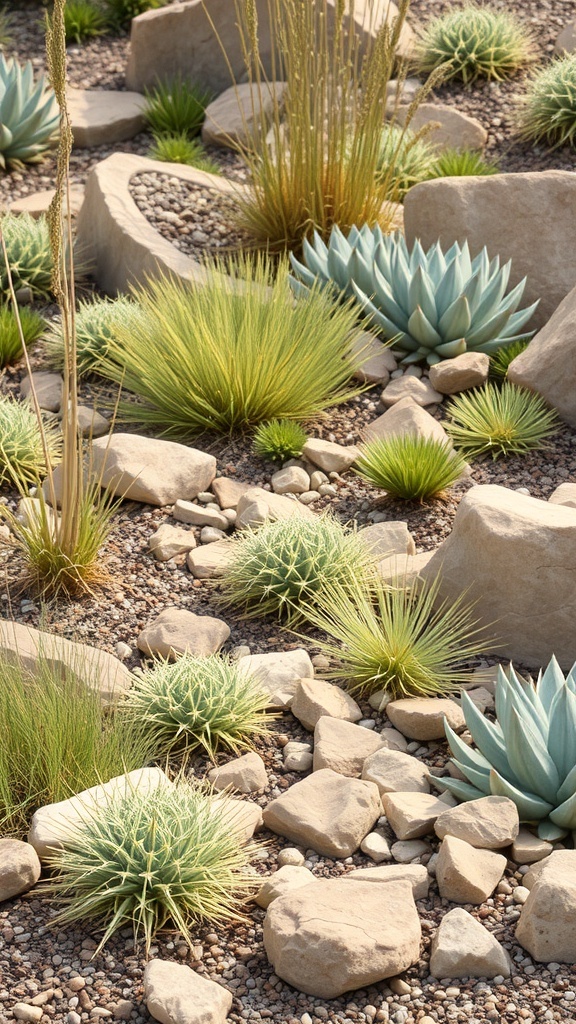
Rock beds are a fantastic choice for xeriscaping, which focuses on reducing water use in landscaping. The image shows a beautiful arrangement of rocks and drought-resistant plants. This setup not only looks great but also thrives in dry conditions.
The rocks create a natural look while helping with drainage. They keep the soil cool and reduce evaporation. The plants, like succulents and grasses, are perfect for this environment. They require minimal water and add texture and color to the landscape.
Using rock beds can also cut down on maintenance. Without the need for regular watering and mowing, you’ll save time and effort. Plus, it’s an eco-friendly option that supports local wildlife.
Overall, rock beds are a smart and stylish way to create a xeriscape garden. They blend functionality with beauty, making your outdoor space both practical and inviting.
Selecting Plants for Rock Beds
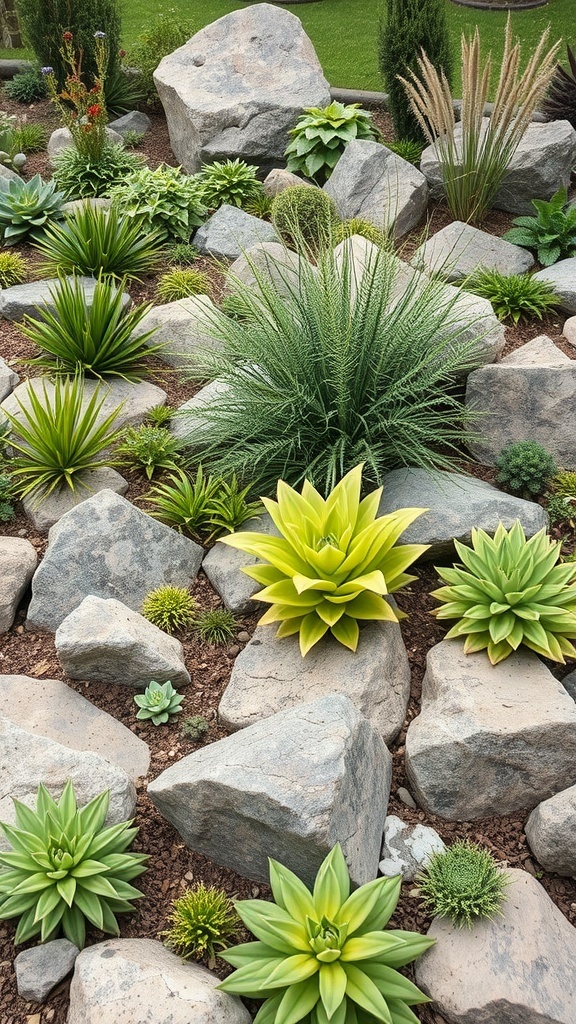
Rock beds can be a stunning addition to your home landscape. They offer a unique way to showcase plants while creating a natural look. When choosing plants for these areas, think about their size, color, and texture.
In the image, you can see a variety of plants nestled among rocks. The greenery contrasts beautifully with the stones, creating a lively scene. Look for plants that thrive in your climate and require minimal water, especially if your rock bed gets a lot of sun.
Succulents are a fantastic choice for rock beds. They come in various shapes and colors, adding visual interest. The larger plants in the image, like the vibrant yellow ones, can serve as focal points. Smaller plants can fill in the gaps, creating a lush appearance.
Don’t forget about the height of your plants. Taller grasses or spiky plants can add vertical interest, while low-growing varieties can soften the edges of the rocks. Mixing different textures will make your rock bed even more appealing.
Lastly, consider the maintenance level you’re comfortable with. Some plants need more care than others. Choose a mix that fits your lifestyle, and you’ll enjoy a beautiful rock bed for years to come.
Using Gravel vs. Larger Rocks
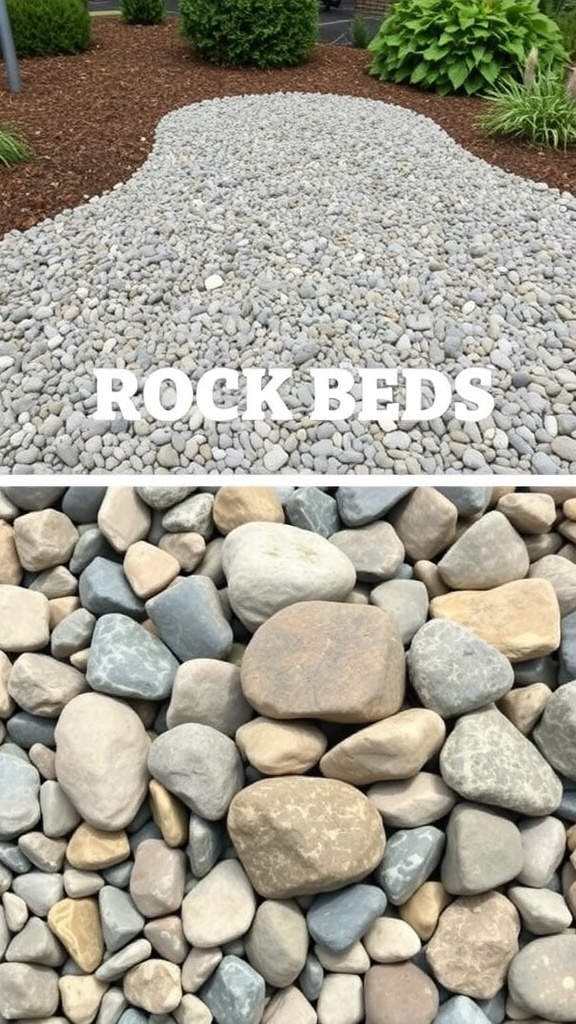
When it comes to landscaping, choosing between gravel and larger rocks can really change the look of your outdoor space. The image shows two different types of rock beds. The top part features smooth, smaller gravel, while the bottom displays larger, more varied stones.
Gravel is often used for pathways and garden beds. It’s easy to walk on and provides good drainage. The smaller size allows for a neat, uniform appearance. Plus, it’s great for filling in spaces where you want a clean look.
On the other hand, larger rocks can create a more natural, rugged feel. They can serve as focal points in your garden or be used to create borders. These stones add texture and can be perfect for areas where you want to discourage weeds.
Ultimately, the choice between gravel and larger rocks depends on your style and the function you want your rock beds to serve. Think about how you want your outdoor space to feel and look, and choose accordingly!
DIY Rock Bed Installation
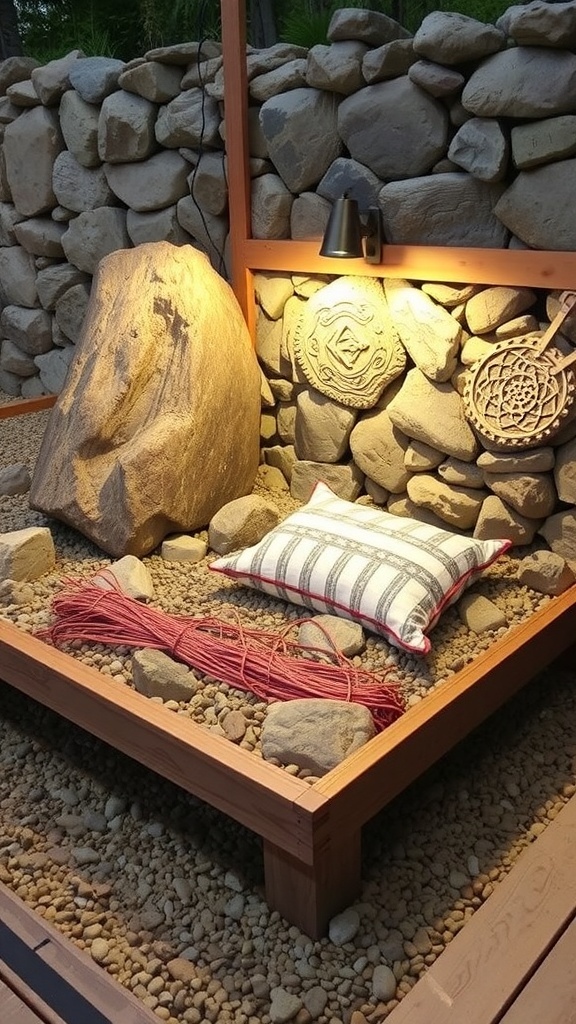
Creating rock beds around your house can add a unique touch to your outdoor space. The image shows a step-by-step process of how to install these rock beds effectively. It’s a fun DIY project that can enhance the look of your garden.
The first step involves planning your layout. You want to decide where you want the rock beds to go. In the image, you can see a circular design around a tree, which is a great way to highlight a focal point in your yard.
Next, you’ll need to gather your materials. This includes rocks of various sizes, landscaping fabric, and possibly some edging stones. The image illustrates how to arrange the rocks neatly, creating a clean and organized look.
Once you have your layout and materials ready, it’s time to dig. You’ll want to remove any grass or weeds from the area. This will help prevent unwanted growth in your rock bed. The image shows a clear path where the rocks will be placed, making it easy to visualize the final result.
After digging, lay down landscaping fabric to keep weeds at bay. Then, start placing your rocks. The image provides a visual guide on how to stack and arrange them for the best effect. Remember to mix different sizes for a more natural look.
Finally, step back and admire your work! Rock beds not only look great but also require less maintenance than traditional flower beds. They can help with drainage and add texture to your garden. With a bit of effort, you can create a beautiful rock bed that complements your home.
The Aesthetic Appeal of Rock Beds
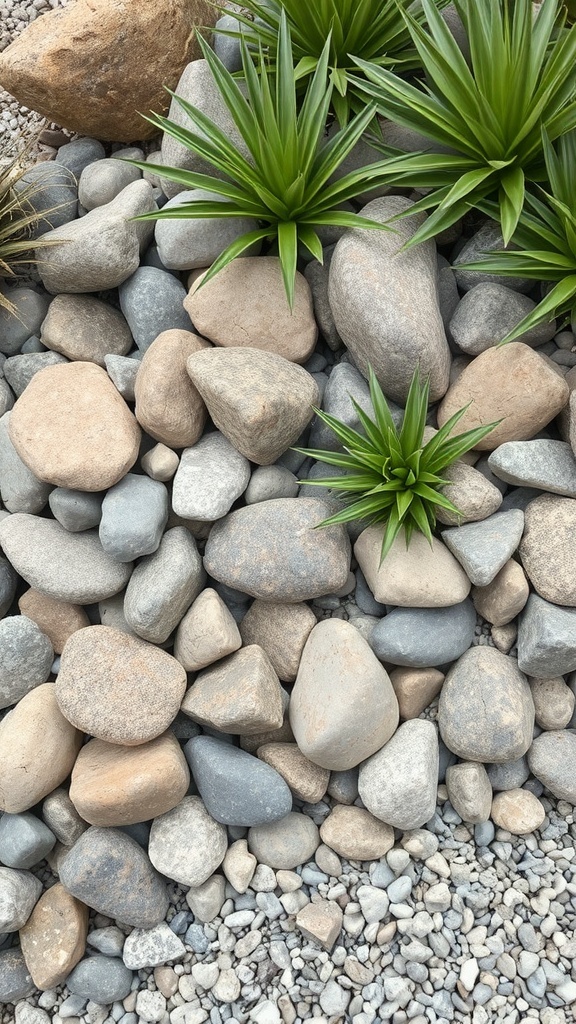
Rock beds around a house can really enhance its look. They add a natural touch that blends well with various styles. The image shows a mix of smooth stones and vibrant green plants. This combination creates a pleasing contrast that draws the eye.
Using rocks in landscaping is a smart choice. They require less maintenance than traditional gardens. Plus, they can help with drainage, keeping your yard looking fresh and tidy. The different sizes and colors of the stones can create interesting patterns, making your outdoor space feel unique.
Incorporating plants among the rocks adds life to the scene. The greenery softens the hard edges of the stones, creating a balanced look. This setup invites you to enjoy the space more, whether you’re relaxing or entertaining guests.
Incorporating Edible Plants in Rock Beds
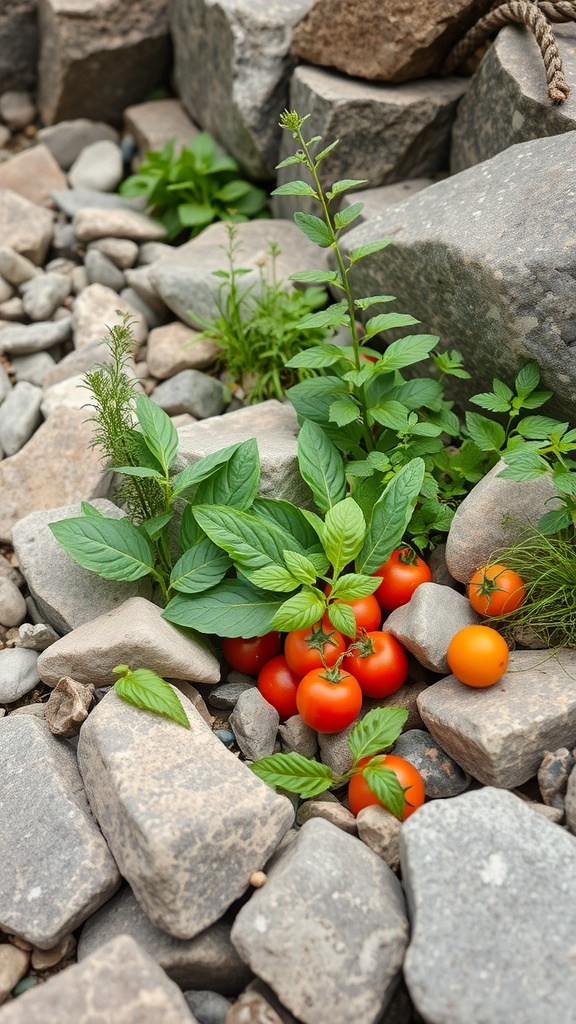
Rock beds can be more than just a decorative feature around your house. They can also be a great spot for growing edible plants. The image shows vibrant tomato plants nestled among stones, showcasing how well these plants can thrive in such an environment.
Using rock beds for growing vegetables like tomatoes is a smart choice. The stones help with drainage, preventing water from pooling around the roots. This setup creates a warm microclimate, which is perfect for ripening fruits. Plus, the contrast of green leaves and red tomatoes against the rocks is visually appealing.
When planning your rock bed garden, think about companion planting. Herbs like basil and mint can grow well alongside tomatoes. They not only enhance the flavor of your dishes but also attract beneficial insects. This creates a mini-ecosystem that supports plant health.
Maintaining a rock bed garden is easy. Regular watering and occasional weeding keep it looking great. Harvesting fresh tomatoes right from your garden is a rewarding experience. You can enjoy them in salads, sauces, or just as a snack. So, why not turn your rock beds into a productive space?
